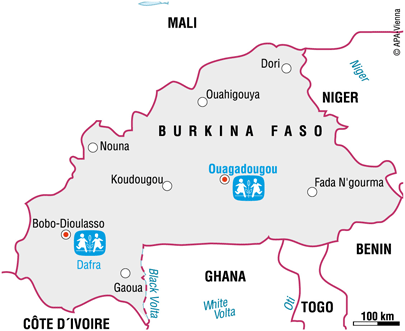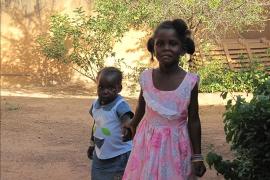
Vi er i Burkina Faso
Some facts about Burkina Faso
In August 1960, the country gained complete independence from France, but a number of military coups followed. It is now a semi-presidential Republic and a member of the African Union (AU). The country was known as "Republic of Upper Volta" until 1984.
Burkina Faso is an extremely poor country characterised by one of the lowest per capita GDPs in the world. Although the country is rich in gold, cotton production is the main pillar of the economy. Compared to other African nations, its industrial base is rather weak and natural resources are scarce. 90 per cent of the country's labour force work in the agricultural sector.
In 2011, widespread popular protests over police brutality, autocracy and rising food prices triggered international media attention. The protests were soon quieted by the authorities, who promised to make changes to the current constitution in order to make Burkina Faso a more democratic state.
Increasing poverty in spite of economic growth
In 2009, massive flooding forced thousands of Burkinabe to leave their homes. More than 50,000 people lost everything in the floods were living in tents and shacks across the capital. Hundreds of schools and a number of hospitals were destroyed by the floods. Aid organisations provided tents, medical equipment and water purification tablets in order to prevent the outbreak of waterborne diseases.
In rural areas, only six per cent of the population have access to proper sanitation facilities. This partially explains the high rate of major infectious diseases such as bacterial diarrhoea, hepatitis A and typhoid fever. At a national prevalence rate of 1.2 per cent, HIV is also a major public health concern. Although the government has included the problem in its general development plan and poverty reduction strategy, thousands of people affected by the virus remain without access to anti-retroviral therapy. However, HIV testing and counselling facilities do exist and efforts to fight the epidemic have been increased. As for now, 17,000 children aged 0 to 14 are HIV-positive. At 53.7 years, life expectancy is very low.
Situation of the children in Burkina Faso
Thousands of young girls in Burkina Faso continue to suffer female genital mutilation (FGM). The operation is commonly carried out by traditional practitioners, mostly without anaesthetics or antiseptics. These women are significantly more likely to have problems during childbirth.
Access to schooling remains difficult in Burkina Faso, particularly in rural areas where the primary school attendance rate is low at only 25 per cent. Only a little more than a quarter of the population knows how to read and write.
SOS Children's Villages in Burkina Faso
Contact:
Villages d'Enfants SOS du Burkina Faso
B.P. 1468
1 – Ouagadougou
Burkina Faso
Tel +226-50 34 61 31
Fax +226-50 34 61 33

